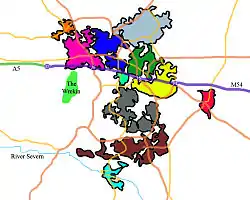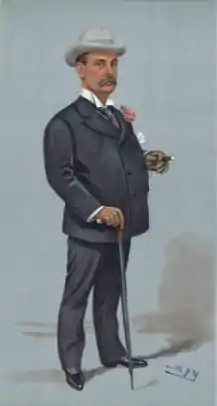Broseley
Broseley is a market town in Shropshire, England, with a population of 4,929 at the 2011 Census and an estimate of 5,022 in 2019.[2] The River Severn flows to its north and east. The first iron bridge in the world was built in 1779 across the Severn, linking Broseley with Coalbrookdale and Madeley. This contributed to the early industrial development in the Ironbridge Gorge, which is now part of a World Heritage Site.[3]
| Broseley | |
|---|---|
 All Saints Parish Church | |
 Broseley Location within Shropshire | |
| Population | 4,929 (2011)[1] |
| OS grid reference | SJ676015 |
| Civil parish |
|
| Unitary authority | |
| Ceremonial county | |
| Region | |
| Country | England |
| Sovereign state | United Kingdom |
| Post town | BROSELEY |
| Postcode district | TF12 |
| Dialling code | 01952 |
| Police | West Mercia |
| Fire | Shropshire |
| Ambulance | West Midlands |
| UK Parliament | |
History
A settlement existed in 1086 and is listed as Bosle in the Domesday Book of that year, when it lay in the Hundred of Alnodestreu. That jurisdiction was dismembered in the time of King Henry I, when Broseley and Willey were reassigned to the Munslow Hundred. Finally they were transferred to the Liberty of Wenlock at its creation in the time of King Richard I. The place name appears as Burewardeslega in 1177, and in similar variants thereafter, indicating that it had anciently been Burgheard's (or Burgweard's) clearing, or grove.[4] In Broseley's manorial history, the medieval family of de Burwardesley was considered by the historian R.W. Eyton to have been a cadet branch of the family of Fulk I FitzWarin of Whittington, Shropshire and Alveston, Gloucestershire.[5]
The town is located on the south bank of the Ironbridge Gorge and so shares much of the history of its better known, but more recent neighbour, Ironbridge.
In 1600, the town of Broseley consisted of only 27 houses and was part of the Shirlett Royal Forest.[6] The area was known for mining; some of the stone used to build Buildwas Abbey was taken from Broseley and there is evidence that wooden wagonways existed in Broseley in 1605,[7] giving Broseley a serious claim to the oldest railways in Britain. The wagonways were almost certainly constructed for the transport of coal and clay and it was these resources that led to the huge expansion of the town during the Industrial Revolution.
Many of the developments celebrated by the Ironbridge Gorge Museum Trust's collection of preserved industrial heritage sites either started in Broseley or were connected to the town. Broseley was a centre for iron-making, pottery and clay pipes; the earliest recorded pipe-maker was working in the town in 1590. The Broseley Pipeworks is one of the trust's ten museums, as is the Jackfield Tile Museum, which is situated in Jackfield, just north-east of the town.[8]
John Wilkinson constructed the world's first iron boat whilst living in the town, and the plans for the Iron Bridge were drawn up in Broseley. Abraham Darby I, who developed the process of smelting iron using coking coal, is buried here.
In the latter half of the 19th century the area suffered an economic decline, as industries moved elsewhere. This left a legacy of uncapped mine shafts, derelict buildings, abandoned quarries, spoil heaps and pit mounds.
In the last thirty years of the 20th century Broseley experienced a modern revival with the development of Telford across the River Severn. New estates were built to the east of Broseley centre, whilst many older properties were developed or renovated, but the town still has fewer inhabitants than it did 200 years ago, when population figures were over 5,000.

Environment
Broseley borders the Ironbridge Gorge World Heritage Site and evidence of involvement in the Industrial Revolution can be seen throughout the town, in the railways, mines, ironworks, brickworks, kilns, houses and fine buildings associated with the area's industrial past.
The jitties (lanes and paths) of Broseley Wood on the western boundary of Broseley are the remains of cottage settlements built for miners. At the other end of the social spectrum the town has many examples of Ironmaster houses, dating from the late 18th and early 19th centuries.
There are two wildlife areas maintained by local groups. The Hay Cop[9] between Dark Lane and Ironbridge Road was the site of the town's water supply and was developed as a nature reserve in 2007. Penns Meadow[10] on the border between Broseley and Benthall is a five-acre ancient meadow and is also being managed to protect and develop wildlife diversity. Both projects have been supported by the Broseley/Barrow Local Joint Committee,[11] a Shropshire Council initiative to encourage devolution of decision-making to local people.
Culture
Broseley's amateur dramatics society, BroADS, puts on several plays a year. Every month, the Birchmeadow Centre is used by Broseley Cinema, to show well-rated films on its own large screen. There is a thriving arts and crafts community that forms a group known as the Broseley Artists.[12]
Since 2009, the Birchmeadow Centre, owned by the Town Council, has hosted live music events, presenting an array of UK and foreign artists, mainly in the folk, blues and ballad genres. They have included such figures as Bill Caddick, Phil Beer, Brooks Williams, Tom Hingley and Steve Knightley. Across the town's pubs and clubs, too, the live music scene is slowly expanding.
Since 2015 residents have held an annual music festival in the town's High Street, usually over the second weekend in June. It features local bands and is supported solely by fundraising events held throughout the year.
The town has a number of historic pubs and eating places, most of them near the town centre. It also has a "Broadplace" facility, a small centre for community usage of laptop computers, help and guidance and free Internet access. Broseley Library, which also has computer access, is located to the south of the town centre, next door to the health centre.[13]
Legacy
The type of bricks and tiles once produced in abundance in Broseley have become synonymous with any product of their type, regardless of where they were made. Broseley bricks are notable for their brown and red mottled nature, a sign of their cheap production, and Broseley tiles are of a strawberry red to light brown hue.
The pipeworks in Broseley were responsible for producing millions of clay pipes that were shipped worldwide. These are invaluable for dating archaeological sites, as they survive without decay and bear a maker's stamp that reveals their date of origin.
Works pioneered here and across the Ironbridge Gorge set the stage for mass production of iron products in the later Industrial Revolution that drove the expansion of the British Empire. This is due in part to the work of John Wilkinson and his construction of precision-engineered steam engines and weaponry.
Local government
Broseley is a civil parish with the status of a town and as such has a town council chaired by a town mayor. It is in the part of Shropshire administered by Shropshire Council, a unitary authority; prior to 2009 it formed part of the district of Bridgnorth.
Education
There are two primary schools: Broseley Church of England or Dark Lane School and John Wilkinson School, named after a noted ironmaster who lived nearby. For secondary education, most pupils travel to William Brookes School in Much Wenlock or further afield to Abraham Darby Academy in Madeley and elsewhere.
Notable people
In birth order:


- Abraham Darby I (1678–1717), industrialist and innovator, was buried here.
- John Guest (1722–1785 or 1787) was a brewer, farmer and coal merchant here.
- John Wilkinson (1728–1808) lived here and devised a method of boring cannon of increased accuracy.
- Peter Onions (1724–1798), ironmaster and inventor of an early puddling process to refine pig iron into wrought iron, was born here.
- Jabez Carter Hornblower (1744–1814), pioneer of steam power, was born here.
- William Reynolds (1758–1803), ironmaster and scientist, died in Broseley.
- John Russell (1788–1873), industrialist and colliery owner in South Wales, was born here.
- George Pearce Baldwin (1789–1840), iron founder at Stourport-on-Severn and grandfather of Stanley Baldwin, was born here.
- John Pritchard (1797–1891), lawyer, banker and Conservative MP for Bridgnorth, was born here.
- Charles Henry Hartshorne (1802–1865) an English cleric and antiquary, was born here.
- Favell Lee Mortimer (1802–1878), religious and educational writer, lived at Broseley Hall before eventually settling with her husband in Norfolk.[14]
- Osborne Gordon (1813–1883), Oxford college tutor and Church of England clergyman, was born here.
- Rowland Hunt (1858–1943), Conservative MP for Ludlow, died at Lindley Green, Broseley.
- Sir Thomas Salter Pyne CSI (1860–1921), an engineer based in Afghanistan, was born here.
- William Whitehead Watts (1860–1947), geologist, was born here.
- Hermione Baddeley (1906–1986), film and theatre actress, was born here.
- Leroy Watson (born 1966), archer and member of the 1988 Olympic bronze medallist team, was born here.
- Shane Embury (born 1967), bassist in the grindcore band Napalm Death, was born here.[15]
- Ben Simons (born 1986), Olympic bobsleigher, was born here.
See also
References
- "Broseley (Parish): Key Figures for 2011 Census". Neighbourhood Statistics. Office for National Statistics. Archived from the original on 4 March 2016. Retrieved 23 November 2015.
- City Population. Retrieved 19 December 2020.
- "Ironbridge Gorge Museums: Great Family Days Out". Ironbridge Gorge Museum. Archived from the original on 15 April 2009. Retrieved 22 June 2016.
- E. Ekwall, The Concise Oxford Dictionary of English Place-Names, 4th Edition (Clarendon Press, Oxford 1960), p. 69.
- R.W. Eyton, Antiquities of Shropshire (John Russell Smith, London 1855), II, pp. 1-38 (Google).
- Ordnance Survey – Shirlett Common Retrieved 31 October 2017.
- http://www.stephensonloco.org.uk/time_line.htm
- Barrie Trinder: The Industrial Revolution in Shropshire (Phillimore, 1981), p. 242.
- "Archived copy". Archived from the original on 15 July 2011. Retrieved 2010-10-20.CS1 maint: archived copy as title (link)
- "Archived copy". Archived from the original on 7 August 2013. Retrieved 2013-01-21.CS1 maint: archived copy as title (link)
- "Archived copy". Archived from the original on 7 August 2011. Retrieved 2010-10-20.CS1 maint: archived copy as title (link)
- Shropshire Council Retrieved 31 October 2017.
- Town Council site. Retrieved 1 June 2020.
- Dickins, Gordon (1987). An Illustrated Literary Guide to Shropshire. Shropshire Libraries. pp. 52, 91. ISBN 0-903802-37-6.
- "Archived copy". Archived from the original on 15 April 2008. Retrieved 26 November 2007.CS1 maint: archived copy as title (link)
External links
| Wikimedia Commons has media related to Broseley. |
- Broseley Town Council website
- Broseley's own website of What's On and links to clubs, shops, accommodation and more – visitbroseley
- Broseley History Society
- British History Online on Broseley.